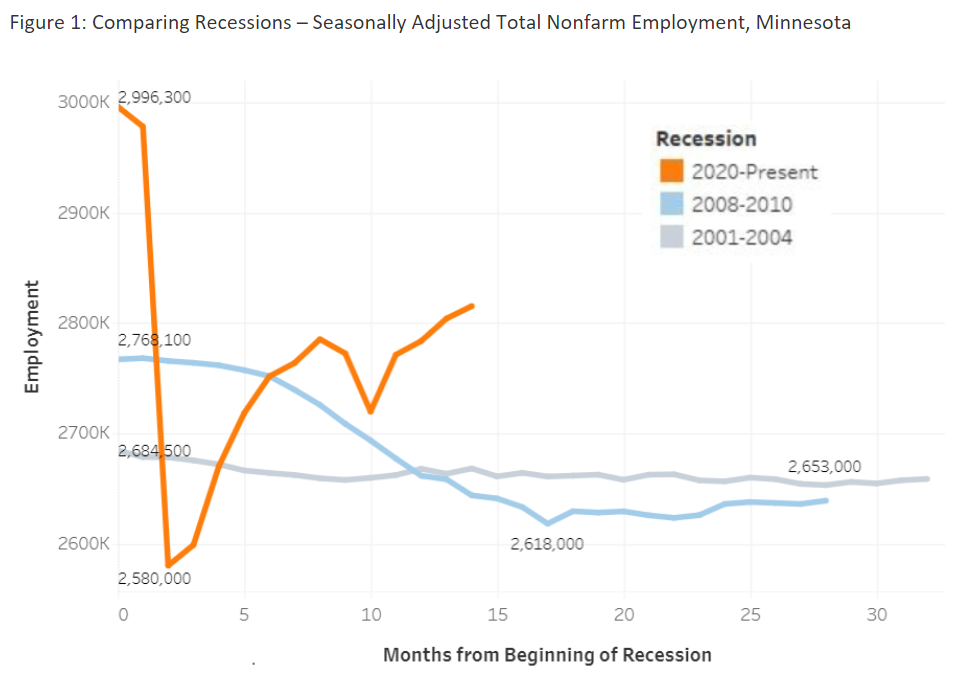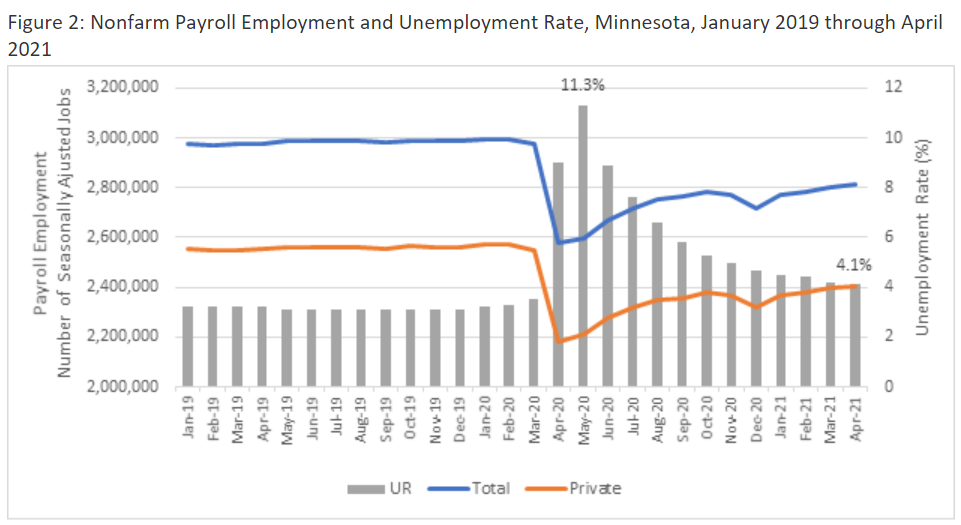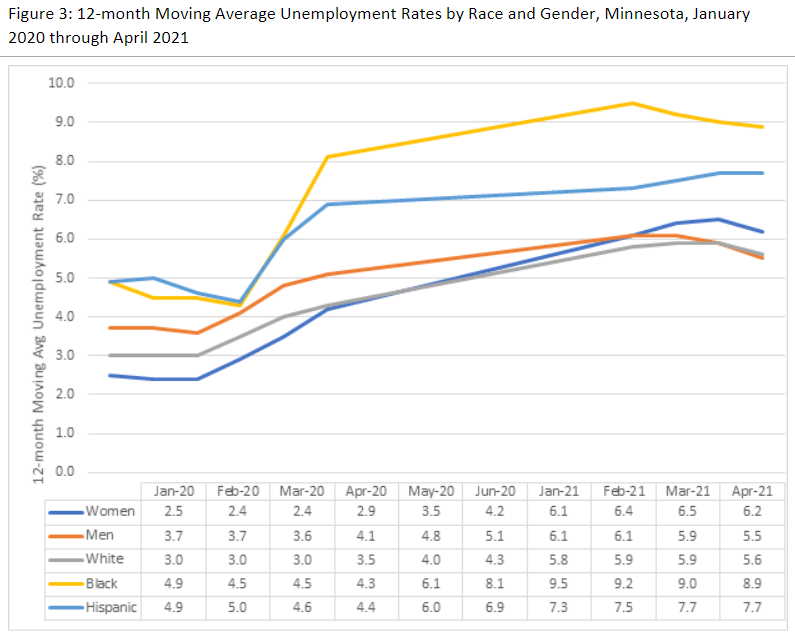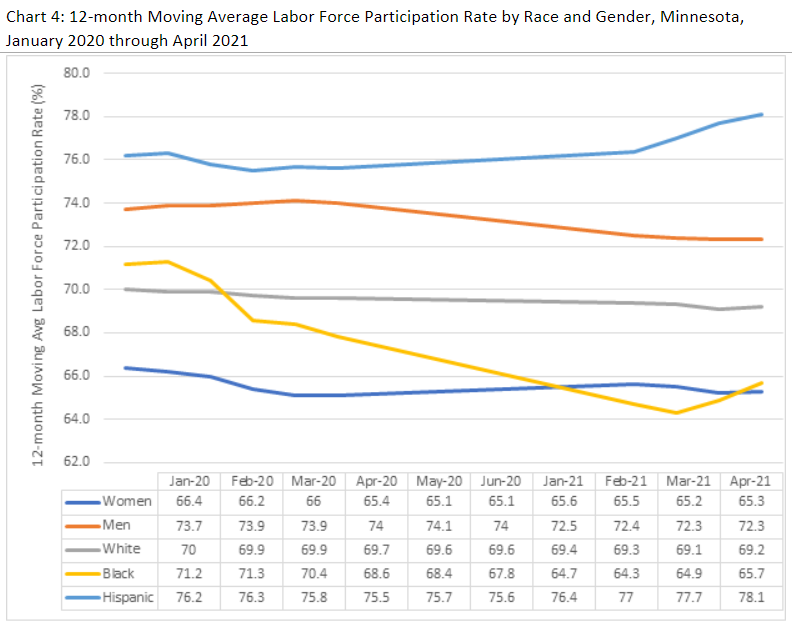

by Nicholas Dobbins and Oriane Casale
June 2021
The pandemic recession is unlike any other recession we've seen in a number of ways. The job loss and job gain pattern are very different than we've seen in the past (see Figure 1). Job loss was far steeper and deeper than we've seen in past recessions. Job gain has also been quicker. Employment forecasts show Minnesota just 61,000 jobs short of pre-pandemic employment by March 2022. Moreover Minnesota's GDP was very close to pre-pandemic levels by third quarter 2020, the most recent data available.
On the flip side, the state's labor market has been tight throughout the first four months of 2021, less than a year after the recession began. Job vacancies remained high, unemployment dropped quickly and wages are beginning to grow. There are indications that the constraints on job growth are more on the supply side than the demand side at this point in the rebound. However, over the next six months most workers who dropped out of the labor force during the pandemic will return. Moreover, new workers, primary among them teenagers coming into the workforce for the first time, should be drawn into the labor market by the plentiful job opportunities.
The pandemic recession hit low wage and Black, Indigenous and People of Color (BIPOC) workers particularly hard because the industries most impacted have the highest concentrations of low wage workers and workers of color. These workers were the first to be laid off and in many cases are going to be the last to be rehired as these industries begin to rebuild. Employers in all industries need to remain creative and flexible around recruiting and training in order to access the talent that they need among workers whose experience may have been in other industries or occupations prior to the pandemic.

Minnesota nonfarm employment growth was deeply into the red for most of 2020, as the COVID-19 crisis had profound negative effects on the labor market both here in Minnesota and nationwide. The effects of the pandemic hit hardest in April 2020, when we lost 362,496 jobs (12.4%) in a single month (see Figure 2). This marked a 13.4% over-the-year (OTY) decline. It was the single-worst OTY job loss in the CES series' history. The second-largest loss came during the Great Recession in September 2009, when employment was down by 5%. While unprecedented historically, the declines in Minnesota were in line with nationwide estimates, as the country also lost 13.4% of jobs OTY in April 2020. Because the Minnesota series only goes back to 1950, and the U.S. to 1939, both miss the effects of the Great Depression, which is likely the closest historical analogue for the losses we saw during the pandemic recession.

Following April 2020's historic declines, employment began to slowly return to the state over the course of 2020 and the first months of 2021. OTY job losses shrank consistently throughout the year, with the exception of two months in late 2020 due to the late fall spike in COVID-19 cases. By March of 2021, annual losses were down to 5.8%, with nearly every supersector posting steady improvements in the interim. Despite this steady growth, the recovery is far from over. April 2021 employment, the most current estimate as of the time of writing, was up 230,463 over April 2020's all-time low, but still 138,242 lower than April of 2019.
No geographic region or industry group was immune to the COVID-19-driven declines in 2020. Every MSA primarily within Minnesota posted negative OTY growth on average in 2020, as did every supersector in the state. The biggest losses were in the industries most effected by COVID-19-related safety precautions. Leisure & Hospitality, which includes restaurants and hotels, posted the steepest declines, off by 54.1% OTY in April and 26.4% on average over all of 2020. Other Services, which includes hair stylists and other personal care services, was down 32% in April and 13% on average in 2020.
While the full shape of the recovery has yet to be revealed, so far state and national employment appear to be returning slowly but steadily. While it remains possible that a sharp recovery will appear as vaccinations rise and people become more comfortable returning to work, the trend so far suggests we could be in for many more months of incremental growth before we return to pre-COVID-19 levels of employment.
Unemployment spiked to 11.3% in May 2020, the highest rate on record for Minnesota dating back to 1976, the earliest for which such data is available. The next highest rate, 8.0%, was recorded during 2009 and lasted four consecutive months. Minnesota's unemployment rate has fallen ever month since May 2020. In April 2021, just 11 months later, it was 4.1%, just 19,366 unemployed workers above its level in February 2020 prior to the pandemic. During the Great Recession, it took 62 months for the unemployment rate to drop to 4.1% from the peak of 8.0%.
Maybe more concerning is the number of people who have dropped out of the labor market since February 2020. At 3,022,528, Minnesota's labor force in April 2021 was 94,553 below its February 2020 level. It is likely that many of these workers will return when they feel safe and able to. Moreover, some of these workers may be waiting to be called back to their previous employers. Workers are considered out of the labor market if they expect to return to their previous employers and therefore are not actively looking for other work but do not yet have a call back date, even if they are receiving Unemployment Insurance (UI) benefits.
The U.S. has seen a similar pattern. In April 2021 Minnesota ranked 13th for lowest unemployment rate among the states, with the U.S. rate at 6.1%. Minnesota's labor force shrank by 3.0% compared to 2.2% nationwide, comparing February 2020 and April 2021.
Despite this drop, Minnesota continued to enjoy a higher labor force participation rate, at 67.7% in April 2021, than the nation, at 61.7%. Our employment to population ratio, or the share of the population that is working, is also high, at 65.0% compared to 57.9% nationwide in April 2021. Our relatively high labor force participation rate and employment to population ratio coupled with our low unemployment rate indicates a tighter labor market than nationwide.
Regardless of these positive signs, there are strong indicators that many workers are still facing great challenges returning to employment. In Minnesota, 12-month moving average unemployment rates were up for all reported race and gender groups (see Figure 3) over the course of the pandemic. But women and Black Minnesotans saw the largest increase in unemployment during this time frame. Rates for these two groups are still up 3.8 and 4.4 percentage points respectively compared to February 2020. Rates were up 2.7 percentage points for Hispanic workers, 2.6 percentage points for white workers and 1.8 percentage points for men in Minnesota.

Labor force participation rates for Minnesota women bucked the national trend. Women in Minnesota did see a small decline in labor force participation, down 0.9 percentage points, but not nearly as large as men, who saw a 1.6 percentage point drop. Initial data indicate that Minnesota did not see the child care industry shrink nearly as much as it did in other states. Additional support for child care programs and after school programs in Minnesota seems to have kept this industry stronger than in other states, which may have played a roll in helping to bolster women's labor force participation. Ongoing access to child care may have helped Minnesota women continue working or seeking work throughout the pandemic.
By race, Black Minnesotans experienced a 5.6 percentage point decline in labor force participation between February 2020 and April 2021 and white workers saw a 0.7 percentage point decline. Hispanic Minnesotans were the only demographic group measured that saw an increase in labor force participation, up 1.8 percentage points over the same period (see Figure 4).

The relatively low unemployment rate and the sharp drop in the labor force is a concern for Minnesota employers who are trying to hire workers in large numbers right now. At the same time there are an additional 13,500 workers who are working part time but who would prefer to work fulltime and who have been unable to find fulltime work, an increase of 38.5% between February 2020 and April 2021. This is an untapped source of labor that employers should consider when structuring jobs. Figuring out how to combine part time jobs into fulltime jobs could help employers recruit and workers find more stable and well-compensated employment.
Long-term unemployment, 27 weeks or more, was up 219.8% or 24,400 people between February 2020 and April 2021. These people report actively seeking work but not being able to find work in their area, in their field or that otherwise meets their families needs. Moreover, the median duration of unemployment has increased from 7.5 weeks in February 2020 to 16.8 weeks in April 2021. This indicates that many more workers are having difficulty finding reemployment than pre-pandemic and that employers may need to rethink their recruiting and on-the-job training practices.
This is the only recession in which we've seen high levels of jobs vacancies at the same time that we've seen high levels of unemployment. Even during the second quarter of 2020, when unemployment was at historic highs, Minnesota had 111,800 unfilled job openings, just 24% lower than the previous year, based on the Minnesota Job Vacancy Survey. By fourth quarter 2020, job vacancies, at 127,300, had recovered to the level of the previous year, with only slightly more unemployed workers than openings at 1.1 worker for every job opening. Tracking the number of job vacancies posted on MinnesotaWorks.net, Minnesota's official job bank, through May 2021 indicates that postings have remained high throughout the recovery period.
Despite overall high numbers, Minnesota Job Vacancy Survey results for fourth quarter 2020 show why so many workers were having difficulty finding reemployment during that time period. Some of the occupations with the greatest number of layoffs at that time had lower than usual numbers of vacancies including Building & Ground Maintenance & Cleaning which had the lowest number of vacancies since 2013 and Food Preparation & Serving, which had the lowest number of vacancies since 2016. On the other hand, Retail Sales Workers as well as Health Care Practitioners & Technical workers had record high number of vacancies.
We know that during third quarter 2020, workers laid off from Leisure & Hospitality jobs who found reemployment with a different employer, were most likely to find a job in Retail Trade. This makes sense both based on the types of skills needed and education required for the two industries, as well as the large number of openings in Sales & Related occupations.
Overall, median wage offers were up by almost a dollar during fourth quarter 2020 compared to the previous year. But looking at the industries that were hardest hit, Food Preparation & Serving saw a small over-the-year decrease in the median wage offer while Retail Sales Worker occupations saw an increase of $1.91, the highest over-the-year increase on record for this occupation going back to 2001, the earliest such data is available. This indicates that employers were willing to offer more to attract workers to retail jobs at the end of 2020. There is some evidence that upward pressure on wages is also beginning to be seen in Leisure & Hospitality, especially food service, in the first part of 2021. Vacancies and wages will be some of the many labor market indicators we will continue to track as we emerge from the pandemic recession.
As of the mid second quarter of 2021, the lack of growth in the state's labor force was likely holding Minnesota back from more rapid job growth. It is likely that constraints on job growth from the labor supply side will decrease in the coming months as vaccination rates continue to tick up and people's lives get back to normal. It is important to understand that the pandemic recession is like none we have ever witnessed from the steepest and deepest job losses to the fastest job rebound ever recorded. These dramatic shifts in the labor market will take time to rebalance as employers and workers navigate the matching process. Mismatches between the skills that employers are looking for and the skills of available workers, as well as mismatches in location, work schedule, and other aspects of jobs, will mean that employers need to remain creative and flexible and job seekers need to actively engage in job search and be willing to learn new skills.